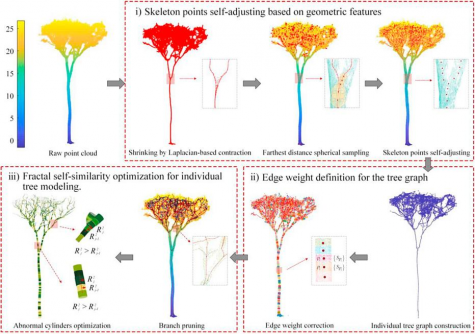Science
New 3D Tree Modeling Technique Achieves Near-Perfect Accuracy

A groundbreaking study has introduced a new method for 3D tree modeling that achieves near-perfect accuracy in reconstructing tree structures. This innovative approach combines skeleton graph optimization with fractal self-similarity, significantly reducing common errors found in existing models, such as inaccurately connected branches and gaps from incomplete data scans. The research was conducted by a team led by Zhenyang Hui at the East China University of Technology and published in the journal Plant Phenomics on June 1, 2025.
The methodology was rigorously tested on 29 trees from diverse tropical forest sites in Peru, Indonesia, and Guyana. Results showed that the newly developed model, termed SfQSM, achieved a concordance correlation coefficient of 0.994, outperforming widely used models such as TreeQSM and AdQSM. This high level of accuracy reinforces its potential application in ecological research, forest management, and biodiversity assessments.
Trees are crucial for maintaining ecosystem balance, supporting biodiversity, and combating climate change. Precise 3D models enable scientists to calculate essential parameters like diameter at breast height (DBH), above-ground biomass, and wood volume. These calculations are vital for estimating carbon stocks and understanding forest structure. Traditional methods for creating tree models often produce fragmented or erroneous connections and struggle with incomplete canopy data.
The research team employed LiDAR (Light Detection and Ranging) technology to gather point cloud data, which was crucial for their modeling. A Riegl VZ-400 terrestrial laser scanner operating at 1550 nm was used to capture high-resolution data, achieving co-registration with 1 cm precision. To validate their model, the researchers destructively harvested all trees to calculate the volumes of stems, buttresses, and large branches using established forestry formulas. This provided benchmark data against which they could assess the accuracy of SfQSM.
The outcomes were impressive. SfQSM produced highly accurate volume estimates, with deviations from harvested volumes generally falling between −1 m3 and 1 m3 across all sites. Notably, smaller-diameter trees from Indonesia showed lower deviations, while larger trees in Peru had greater discrepancies. This suggests that tree size influences the precision of modeling efforts.
Quantitative analysis revealed that SfQSM achieved a mean deviation of 0.162 m3 and a root mean square error of 1.023 m3, with relative errors as low as 0.01% and 0.09%. In contrast, errors for TreeQSM were more than twice as high, and AdQSM’s deviations exceeded those of SfQSM by over thirtyfold. The visual reliability of SfQSM was also evident, as it consistently generated continuous, realistic models. In contrast, TreeQSM often yielded fragmented trunks, while AdQSM produced overfitted or non-existent branches.
These findings highlight SfQSM’s superiority in both statistical accuracy and structural fidelity. With the ability to create precise individual tree models, this method supports biodiversity assessments, species classification, and habitat analysis. Additionally, it enhances the estimation of tree volume and biomass, essential for calculating carbon stocks and understanding the role of forests in the global carbon cycle.
The implications of this research extend beyond academia. Accurate 3D reconstructions can inform sustainable forestry practices and reforestation initiatives, contributing to climate change mitigation strategies. As the need for effective forest management grows, innovative tools like SfQSM stand to play a pivotal role in the future of ecological conservation.
The study received financial support from several sources, including the National Key Laboratory of Uranium Resources Exploration-Mining and Nuclear Remote Sensing and the National Natural Science Foundation of China.
As the field of plant phenomics continues to evolve, this research underscores the importance of advanced modeling techniques in enhancing our understanding of forest ecosystems.
-

 Lifestyle5 months ago
Lifestyle5 months agoLibraries Challenge Rising E-Book Costs Amid Growing Demand
-

 Sports4 months ago
Sports4 months agoTyreek Hill Responds to Tua Tagovailoa’s Comments on Team Dynamics
-

 Sports4 months ago
Sports4 months agoLiverpool Secures Agreement to Sign Young Striker Will Wright
-

 Lifestyle4 months ago
Lifestyle4 months agoSave Your Split Tomatoes: Expert Tips for Gardeners
-

 Lifestyle4 months ago
Lifestyle4 months agoPrincess Beatrice’s Daughter Athena Joins Siblings at London Parade
-

 Science4 months ago
Science4 months agoSan Francisco Hosts Unique Contest to Identify “Performative Males”
-

 World4 months ago
World4 months agoWinter Storms Lash New South Wales with Snow, Flood Risks
-

 Science5 months ago
Science5 months agoTrump Administration Moves to Repeal Key Climate Regulation
-

 Business5 months ago
Business5 months agoSoFi Technologies Shares Slip 2% Following Insider Stock Sale
-

 Science5 months ago
Science5 months agoNew Tool Reveals Link Between Horse Coat Condition and Parasites
-

 Sports4 months ago
Sports4 months agoElon Musk Sculpture Travels From Utah to Yosemite National Park
-

 Science5 months ago
Science5 months agoNew Study Confirms Humans Transported Stonehenge Bluestones









